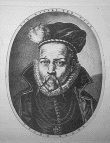
courtesy http://imagine.gsfc.nasa.gov/docs/science/how_l1/timing.html
Tycho Brahe (1546-1601)

courtesy
http://imagine.gsfc.nasa.gov/docs/science/how_l1/timing.html
Tycho Brahe (1546-1601)
Tycho Brahe was one of the most colorful characters in the history of astronomy. He was born into Danish nobility and used his "resources" to promote a lavish lifestyle and make advancements in astronomy. Gaining the favor of the king (Frederick II), he was able to construct two observatories ... Uraniborg (Castle of the Heavens) and Stjerneborg (Star Castle). These observatories did not have telescopes (which weren't invented until after Tycho's death), but rather, used naked eye observations which were accurate to 1-2 arc-minutes. This unprecedented accuracy was obtained with the use of an enormous quadrant (quarter circle) with a radius of about 19 feet from which Tycho could make sightings.

Tycho's Quadrant
A tribute to Tycho's personal eccentricities can be seen if you click on his portrait above. You will see that he is missing a piece of his nose ... which was lost during a duel over who was the better mathematician! He constructed a silver replacement (held with beeswax) for normal occasions and a gold nose which was used for royal banquets. Even the manner of his death tells us about his unconventional behavior. History records a night when Tycho attended a royal banquet. During this long feast, Tycho (who was known to drink large quantities of ale) ignored "natures call" ... resulting in a bladder infection (some books say his bladder "blew up" ... which my doctor says is unlikely). Eleven days later he died. In 1996, it was determined that Tycho died from mercury poisoning which was ingested 1 day before his death. Was this a suicide? As you will soon see, his life and death played a prominent role in the way astronomy advanced.
Using his observatories, Tycho spent over 20 years making meticulous naked eye observations of the sky. He was extremely fortunate to observe a supernovae in 1572. For 16 months he carefully studied all aspects of this "guest star" ... including an attempt to measure the distance to it using the method of triangulation. Tycho was unable to observe any parallax and properly concluded that it must be extremely distant (much further than the moon). This was an alarming claim since the Ptolemaic model clearly stated that all heavenly objects must be perpetual and unchanging. According to Ptolemy, chaos was confined to the "realm of man" which must lie inside the orbit of the moon. This seriously weakened the credibility of the Ptolemaic model. In 1577, Tycho observed a comet and made similar claims ... saying it was also much further from us than the moon. Although comets were frequently seen before this, it was always assumed that they were atmospheric events ... not celestial. Another blow to Ptolemy.
One of Tycho's main objectives was to promote a model of the universe by his own design. This model, known as the Tychonic Universe, was a hybrid of the Ptolemaic and Copernican systems. Tycho felt that Earth was stationary at the center of the universe (like Ptolemy), but felt that all the planets were in orbit around the sun (as in Copernicus).
The universe according to Tycho (Jupiter and Saturn are not shown)
Although this model was met with little support, Tycho was extremely proud of it and suspiciously guarded his claim ... fearing others might steal his intellectual property. In 1600, he hired a great mathematician, Johannes Kepler, as an assistant to help develop the Tychonic model. Soon after, Tycho took ill and died (see above). Historians claim that on his deathbed, Tycho summoned Kepler and revealed his grand design, asking ... "Let me not seem to have lived in vain". Upon Tycho's death, Kepler acquired possession of all the astronomical observations made by this "Great Dane". Kepler, however, used it to help support the model he favored - the Copernican universe. With Tycho's data, Kepler was able to make astronomical history.
ŠJim Mihal 2004, 2014, 2022-
all rights reserved